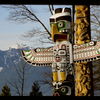Exploring Vancouver's Stanley Park
Julian Worker
Stanley Park is the result of remarkable foresight. In 1886 the newly-created Vancouver city council petitioned the federal government to set aside the then swampy peninsula as a park. The petition was granted and in 1888 Lord Stanley, the Governor General of Canada, dedicated the park to the use and enjoyment of people of all colours, creeds, and customs for all time. Today, Stanley Park welcomes 8 million visitors per year and for most of those people it is Vancouver's outstanding attraction. The park occupies 1000 acres of a headland that juts into the Burrard Inlet. There are beaches on the western side, magnificent rose and rhododendron gardens, intriguing sights, and plenty of fresh air. The dense forest comprises Douglas fir, hemlock, and western red cedar, with an underforest of deciduous maples and alders.
The 5.5 mile walk around the Stanley Park, mostly along the seawall, is a must for all visitors. It orientates you wonderfully and the outstanding views just keep coming. The walk should be done counter-clockwise starting from the Georgia Street entrance. The first building you pass is the Tudor-style Vancouver Rowing Club. The next sight is the wonderful collection of Totem Poles, a photographer's delight. Near the poles and right by the path is a statue of Harry Jerome, who in the early 1960s was the world's fastest sprinter. The view towards the sails of Canada Place is particularly fine from here. The Nine O'Clock Gun still resounds across the harbour each evening. Depending on which story you believe, the gun either called the herring fishermen home or allowed ships in the harbour to set their chronometers. The red and white Brockton Point lighthouse is a popular place for fishermen. Just inland is the Brockton Oval described by the brilliant Australian cricketer Don Bradman as the most beautiful ground in the world. Further on is the Girl in a Wetsuit sculpture sitting in the water by the shore. The dragon figurehead of the ship the Empress of Japan points towards the North Shore; what you see in the park today is a fibreglass copy of the original, which was restored by conservationists at Vancouver's Maritime Museum.
At Lumberman's Arch there is a children's water park. From here it is a short walk to the Vancouver Aquarium and to the Stanley Park Miniature Railway. The span of the Lion's Gate bridge will have been visible for a while. This bridge, completed in 1938, stands 80 metres above the water and was modelled after the Golden Gate bridge in San Francisco. The Lions Gate bridge is named after the body of water it crosses. The Lions are the two sugar loaf peaks on the North Shore. Just past the bridge is Prospect Point the highest point in the park, where you can watch the shipping coming in and out of the port of Vancouver. A cairn commemorates the SS Beaver which sank nearby in 1888. The next sight along the seawall is the 15-metre high Siwash Rock, slightly apart from the rest of the park, which is the subject of an Indian legend recorded a century ago by the Mohawk poet Pauline Johnson, who is buried nearby.
For those looking for peace and quiet, Third Beach should fit the bill. Further on, Second Beach has a tidal saltwater pool, a sandy beach, and a children's playground. The trail then heads away from the sea through the park, where there are tennis courts, bowling greens, and the pitch-and-putt course. You will walk past Lost Lagoon and then when you cross the main road through the park you will be back at the Georgia Street entrance. The Stanley Park Miniature Railway carries 700,000 passengers per year, half of them adults. It's Halloween and Christmas specials are especially popular. You travel in canopied coaches led by a replica of the engine that pulled the first trans-continental train in to Vancouver in 1887. The ride on the narrow-gauge railway takes 10 minutes. The Vancouver Aquarium is home to over 7,000 aquatic creatures, including sharks, piranhas, electric eels, and sea otters. There is no killer whale; the last one was moved to San Diego in 2001. The highlights include the Arctic Canada section where, through large viewing windows, you can see the surprisingly graceful beluga whales swimming underwater, while in the Amazon Rain Forest crocodiles, anacondas, and two-toed sloths will vie for your attention.
There are snack bars at Second Beach, Lumbermen's Arch, and Lost Lagoon. The restaurants in the park are: the upscale Fish House restaurant, the Teahouse restaurant at Ferguson Point, the Prospect Point Cafe, and the Stanley Park Pavilion.
Featured Articles
Surrounded by lush rain forest, the campus of the University of British Columbia (UBC) protrudes into the Pacific Ocean.
Stanley Park is the result of remarkable foresight. In 1886 the newly-created Vancouver city council petitioned the...
While high-end boutiques figure prominently in some Montreal neighborhoods, there are entire streets brimming with bargains.
Nanaimo - VI's second largest city is also known as Harbour City. You can hike, bike, bungy and kayak here.
Vancouver tourist information is located at Centre Plaza Level, 200 Burrard St. (604) 683-2000.
USA/Canada Hostels Guide
hostels, maps, tours, money saving tips, free things to do... GET YOUR FREE COPY.
Featured Articles
Surrounded by lush rain forest, the campus of the University of British Columbia (UBC) protrudes into the Pacific Ocean.
Stanley Park is the result of remarkable foresight. In 1886 the newly-created Vancouver city council petitioned the...
While high-end boutiques figure prominently in some Montreal neighborhoods, there are entire streets brimming with bargains.
Nanaimo - VI's second largest city is also known as Harbour City. You can hike, bike, bungy and kayak here.
Vancouver tourist information is located at Centre Plaza Level, 200 Burrard St. (604) 683-2000.
USA/Canada Hostels Guide
hostels, maps, tours, money saving tips, free things to do... GET YOUR FREE COPY.



